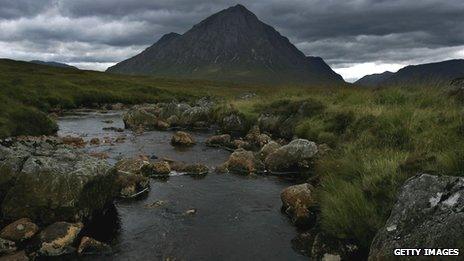How volcanoes shaped Britain's landscape
- Published

Britain's volcanic fires may be no more, but remnants of an enduring eruptive past can be found throughout the country, writes Professor Iain Stewart.
"So there I lie on the plateau, under me the central core of fire from which was thrust this grumbling grinding mass of plutonic rock, over me blue air, and between me the fire of the rock and the fire of the sun, scree, soil and water, moss, grass, flower and tree, insect, bird and beast, wind, rain and snow - the total mountain."
Those words - from Nan Shepherd's recently resurrected gem The Living Mountain (Canongate) - perfectly evoke the intimate relationship between the flora and fauna of upland Britain and its ancient volcanic past.
In this case, the reverence is for the rounded granite bulk of the Cairngorm mountains in north-east Scotland, but across Britain and Ireland rocks born molten many millions of years ago still fashion the familiar natural world around us.
The Cairngorms themselves are the roots of mountains that formed about 420 million years ago when a great seaway separating the rocks of Scotland and Northern Ireland from those of England and Wales crumpled shut.
During the final death throes of that ancient Iapetus Ocean, a chain of explosive volcanic islands had lined the leading edge of the approaching southern landmass of Avalonia - today the jagged highlands of Snowdonia and the Lake District are the ice-sculpted remains of that once fiery frontier.
When Avalonia finally collided with the Celtic fringes of the northern landmass (Laurentia), a mountain range of Himalayan stature was thrown up.
Molten rock (magma) that had readily risen to fuel surface volcanoes now congealed in the depths of the over thickened crust, investing the lofty peaks with granite hearts.
Erosion has now exhumed these granite cores, exposing them in the alpine plateaus of the Cairngorms, and further west, in the boggy bleakness of Rannoch Moor.
So in Britain you do not walk on volcanoes, you walk within them. Take our highest mountain - Ben Nevis. Few of those that take the sturdy hike to its summit probably appreciate that they are journeying through the innards of a disembowelled volcano.
Moreover, it is one that met with a truly cataclysmic end. The clue is found near the summit, where light coloured granite that had cooled in subterranean chambers several kilometres down now lies right up against dark basaltic lavas that once spewed out at the surface. Ordinarily never the twain shall meet.
The fact that today they are found side by side implies that the huge ancient volcano collapsed in on itself. The event, which occurred some 350 million years ago, was of such epic violence that it is almost impossible to imagine today.
To approach anything close you have to leave the bens and glens behind and transport your imagination thousands of miles eastward to the infamous blast in 1883 that ripped the heart out of Krakatoa volcano, west of Java.
Or back several millennia to the even larger Bronze Age eruption of Thera volcano (modern Santorini in Greece) which wiped the Minoan culture off the face of their Aegean heartland.
Over hundreds of millions of years, such extraordinary volcanic actions have laid the foundation for our natural landscape. The signs are all around, if you know what to look for.
In Edinburgh, clamber up to the top of Arthur's Seat - its cliffs a sheet of solidified magma - and you can see isolated rocky pinnacles scattered along the Forth estuary, each the eroded neck of a former volcano.
Or venture west to the Campsie Fells, where the same magma-fuelled maelstrom 300 or so million years ago built a magnificent staircase of lava flows that today rise above Glasgow.
Even amid the lowlands of middle England, volcanic fires once burned - the gentle summits above Church Stretton in the Welsh borderland, for instance, are the outpourings of 600 million year old lavas.
Of course today, those long enduring volcanic fires are extinguished. The last hurrah of the UK volcano was about 55 million years ago, when an extraordinary fiery outburst accompanied the wrenching open of the North Atlantic ocean.
All along what is now the western shores of Scotland, huge volcanic centres erupted colossal quantities of magma. The islands of Arran, Mull and Skye are among the remains of a chain of volcanoes that draped much of northern Britain and Ireland in enormous amounts of lava and volcanic ash.
Deeper fracture lines radiating out from these centres injected Hebridean magma as far south as the North Sea coast of Yorkshire, travelling the 400km in something like five days!
But such volcanic violence was not to last. Over millions of years, the spreading of the Atlantic seaway shunted eastward Hebridean volcanoes away from the well of superheated rock that originally fed them, so that, today, that upwelling now feeds the craters and geysers of Iceland.
With the demise of our home-grown volcanoes, it is to the likes of Iceland and Italy that we must now travel to see our closest live volcanic action. Many UK scientists study active volcanoes in those areas, as well as further afield in the Caribbean islands or around the Pacific Ring of Fire.
But UK volcanologists do so armed with an intimate knowledge of our own volcanic heritage which, exposed by millions of years of erosion, reveals the deep "plumbing" of once active volcanoes.
That is important because volcanoes are far more than just spectacular firework displays. They are also geological windows into our planet - portals that allows geologists to delve deep into how the Earth works.
Professor Iain Stewart and Kate Humble present Volcano Live, from Kilauea on Hawaii, the world's most active volcano. Starting on BBC Two on Monday 9 July at 20:00 BST.
- Published30 May 2012
- Published12 April 2012